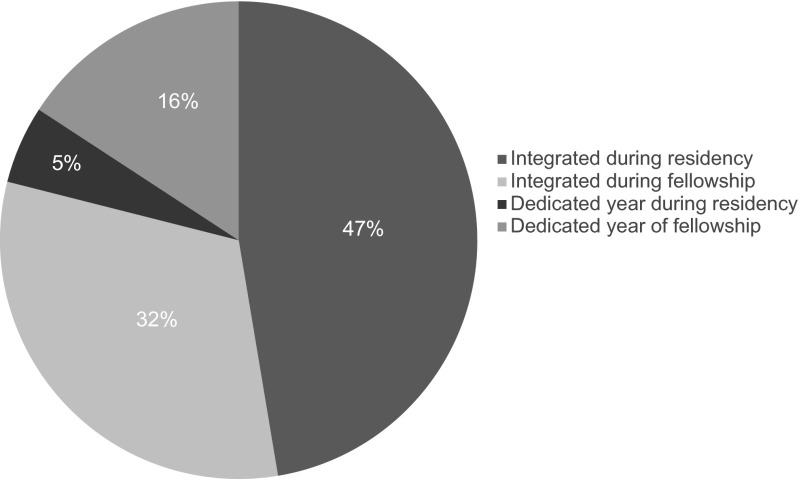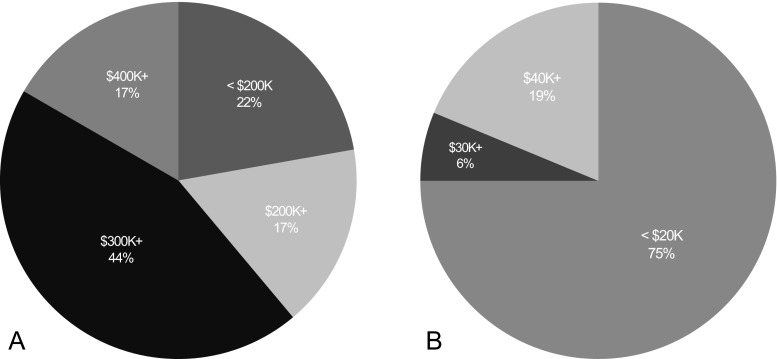Abstract
Imaging informatics (II) is an area within clinical informatics that is particularly important in the field of radiology. Provider groups have begun employing dedicated radiologist-informaticists to bridge medical, information technology and administrative functions, and academic institutions are meeting this demand through formal II fellowships. However, little is known about how these programs influence graduates’ careers and perceptions about professional development. We electronically surveyed 26 graduates from US II fellowships and consensus leaders in the II community—many of whom were subspecialty diagnostic radiologists (68%) employed within academic institutions (48%)—about the perceived impact of II fellowships on career development and advancement. All graduates felt that II fellowship made them more valuable to employers, with the majority of reporting ongoing II roles (78%) and continued used of competencies (61%) and skills (56%) gained during fellowship in their current jobs. Other key benefits included access to mentors, protected time for academic work, networking opportunities, and positive impacts of annual compensation. Of respondents without II fellowship training, all would recommend fellowships to current trainees given the ability to gain a “still rare” but “essential skill set” that is “critical for future leaders in radiology” and “better job opportunities.” While some respondents felt that II fellowships needed further formalization and standardization, most (85%) disagreed with requiring a 2-year II fellowship in order to qualify for board certification in clinical informatics. Instead, most believed that fellowships should be integrated with clinical residency or fellowship training while preserving formal didactics and unstructured project time. More work is needed to understand existing variations in II fellowship training structure and identify the optimal format for programs targeted at radiologists.
Keywords: Education, Medical, Imaging informatics, Informatics training, Internship
Introduction
Informatics is the study of knowledge representation and information processing between persons or systems. In turn, the American Medical Informatics Association defines clinical informatics as the application of informatics and information technology to the delivery of health care services [1]. It represents an important focus for improving the value of care [2] and supporting the national effort to incentivize the use of and infrastructure for health information technology and data sharing [3].
Imaging informatics (II) is an area of clinical informatics that holds particular importance in the field of radiology. Propelled by trends in computer technology, image digitization, and picture archiving and communication systems (PACS), II has emerged as a distinct radiological subspecialty [4, 5]. It has also become a key focus area in national policy that reflects the evolving role of radiologists amid trends in health consumerism, health economics, and government influence [6, 7].
II spans the entire imaging workflow, including pre-image acquisition periods and post-processing and analysis [8, 9]. It encompasses computerized physician order entry, clinical decision support, speech recognition and structured reporting, and communication with patients and referring providers. It can greatly improve the quality and efficiency of imaging services while supporting clinical, educational, and research efforts [6, 10]. Given the ubiquity of technology in daily workflow and important role of II in the future of radiology, provider groups are beginning to employ dedicated radiologist-informaticists to bridge medical, information technology and administrative functions [5].
To meet this growing demand, academic institutions have begun offering formal II fellowship training. Nationally, there are currently at least half a dozen institutions offering such programs, having produced an estimated 30 to 40 graduates to date. Specific formats vary: some offer a fellowship year dedicated entirely to hands-on informatics training while others integrate training with radiology residency, fellowship, or part-time clinical practice [11]. Some select only radiology trainees, while others enroll participants from all medical and allied health concentrations.
As currently available fellowships do not yet fulfill the two-year fellowship experience required for American Board of Medical Specialties (ABMS) certification in clinical informatics [12], it is unclear how existing variations in training structure and duration will affect graduates’ overall career prospects.
Regardless, given current national and local trends, program graduates will play increasingly vital roles in care delivery and/or policy related to imaging services; however, little is known about how these programs influence their graduates’ careers or their perceptions of professional development.
Materials and Methods
We created a 27 item web-based survey (hosted by Qualtrics; www.qualtrics.com) evaluating the perceived impact of II fellowships on career development and advancement. The survey included questions about fellowship training structure as well as respondents’ current employment, compensation, job responsibilities, and participation in national informatics organizations. It also evaluated respondents’ assessment of the usefulness of skills they gained through their II fellowships. Question formats included yes/no and multiple choice, as well as open-ended free text (e.g., “Are there specific skills you learned during the Imaging Informatics fellowship that you now use regularly?”).
Graduates from US II fellowships with available electronic contact information were eligible for participation. For comparison purposes, a group of leaders in the II community who did not complete fellowship training were also identified via consensus among study authors and deemed eligible for participation. Electronic contact information for invitees was by obtained by soliciting fellowship directors and utilizing the study authors’ existing professional relationships with individuals in the II community. Potential participants were invited to complete the survey via e-mail and social media (survey link posted to authors’ Twitter accounts). This study was approved by the Institutional Review Board at the University of Pennsylvania.
Results
Of 36 invitees, 26 (72 %) responded. Twenty responses were completed by former II fellows while six were completed by individuals in the II community without fellowship training. The majority of respondents identified themselves as subspecialty diagnostic radiologists (68 %), and approximately half (48 %) reported current employment within a university-based academic institution. Of those who completed II fellowships, all reported completing training within the last 15 years: half reported being within 5 years of fellowship graduation, while one quarter reported completing fellowship within 6–10 years and 11–15 years.
Fellowship Structure and Certification
The majority of respondents who completed II fellowships reported training in 1-year programs that integrated clinical residency or fellowship training with protected academic and curricular fellowship time (see Fig. 1). Most II fellows were radiology trainees (clinical residents and fellows), but programs frequently also included radiology faculty (44 %) and other radiology support staff (39 %).
Fig. 1.
Structure of current II fellowships
Both those with and without formal fellowship training reported that ideally, II fellowships should be integrated with clinical residency or fellowship training while preserving formal didactics and unstructured project time (see Fig. 2). Many mentioned the importance of professional development, specifically access to mentors and protected time for conferences, meetings, and II networking opportunities. Responses to open-ended items also revealed the opinion that II fellowships needed further formalization and standardization.
Fig. 2.
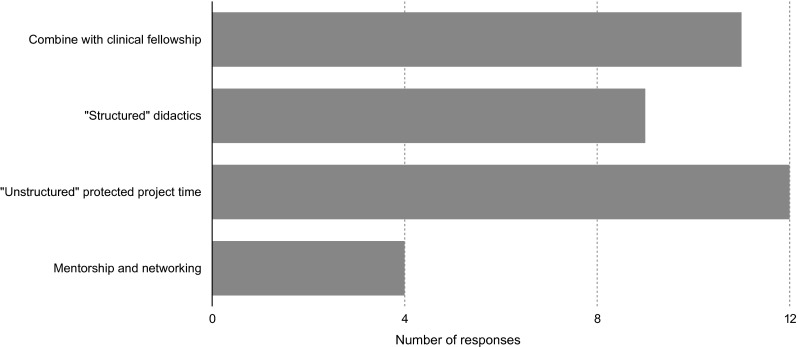
Components of “ideal informatics fellowships”
The majority of respondents (85 %) disagreed with the decision by the ABMS to require a 2-year informatics fellowship in order to sit for board certification in clinical informatics.
Relationship Between Fellowship Training and Professional Development
Most former fellows appeared to have leveraged their training for professional development. All (100 %) felt that having completed an II fellowship made them more valuable to potential employers. Over half (56 %) felt that some of these skills contributed to their obtaining their current jobs, while 30 % believed that fellowship training contributed to receiving at least $30,000 more in annual compensation (see Fig. 3).
Fig. 3.
Compensation. A. Current II fellow graduates’ compensation. B. Perceived increase in annual income as a result of II fellowship training
Sixty-one percent reported continued and regular use of competencies gained during fellowship in their jobs, including those related to technical knowledge, management and communication skills, and understanding of workflow optimization and quality tools (see Fig. 4). The majority (78 %) reported ongoing II roles (see Fig. 5), ranging from membership on information technology committees to prominent leadership positions such as “clinical informatics director” or “chief of imaging informatics.” Of graduates practicing in academic settings, 40 % remain involved in II education as lecturers and fellowship program directors. Other reported fellowship benefits included access to mentors, exposure to vendors, and networking with others in the II community.
Fig. 4.
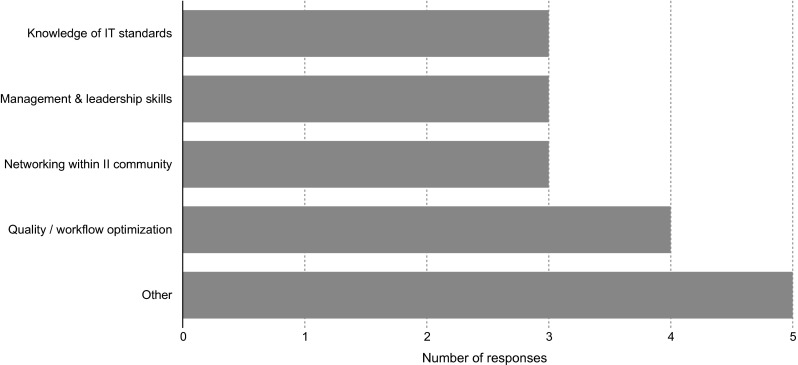
Value-added skills obtained during II fellowship reported by II fellowship graduates
Fig. 5.
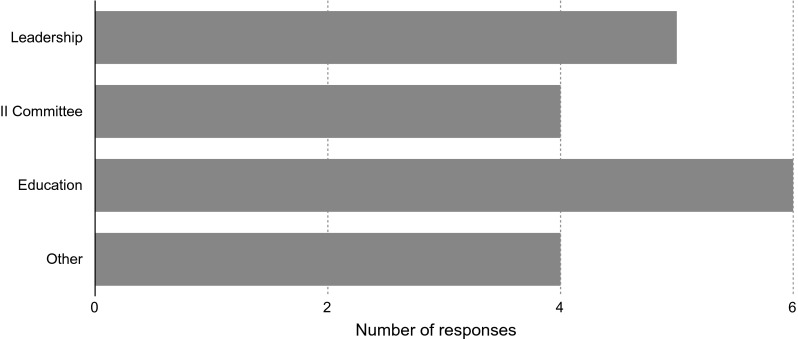
Responsibilities related to II held by fellowship graduates
Of respondents without II fellowship training, 83 % had experience with informatics prior to residency, and 100 % reported completing at least two II-related research projects during residency training. All also reported that they would recommend II fellowships to current trainees, despite having not completed one themselves. Reasons obtained from open-ended responses included the belief that II training provides a “still rare” but “essential skill set” that is “critical for future leaders in radiology,” which would lead to “better job opportunities.”
Insufficient response rate from individuals without formal fellowship training precluded statistical comparisons of between-group differences.
Discussion
Although only a small handful of II fellowships currently exist, graduates already appear to be experiencing the benefits of formal training. Notably, key positives appear to span a spectrum of professional development, including job acquisition, performance of responsibilities, and desire to remain active in II leadership and education. The importance of formal training is underscored by the fact that current II leaders would recommend fellowship to trainees regardless of their own fellowship status. Collectively, these results underscore the importance and emerging demand for radiologists with II training, and the role of fellowship programs in producing that requisite workforce.
Our survey also reveals that additional work is required to clarify and improve the structure and standardization of II fellowship training. While existing programs exhibit variation in duration, structure, and participants, the majority of our respondents reported completion of 1-year programs and strong preferences that fellowship should be integrated into clinical residencies or fellowships. As a result, it is not surprising that the majority of respondents also oppose the 2-year fellowship requirement for board certification in clinical informatics.
Given the ubiquity of technology in daily radiologist workflow, radiology trainees may be able to meet ABMS requirements through shorter fellowship training compared to counterparts from other clinical specialties. During residency, radiologists are already educated on aspects of II and tested on them through the American Board of Radiology’s Core and Certifying exams. Moreover, our survey suggests that programs that integrate informatics fellowships into clinical training can be effective in preparing graduates for professional responsibilities.
Our study is limited by potential underreporting and sampling, recall or non-response bias. Furthermore, low response rates from individuals who did not complete II fellowships precluded measurement of differential impact of formal fellowship training. However, our study achieved a high overall response rate and represents the first evaluation in a rapidly expanding and dynamic field. More work is needed to understand the benefits and limitations of different training structures and identify the ideal format and implementation strategy for radiology focused II fellowships.
Conclusions
II is an emerging field and career development pathway for radiologists. Formal fellowship programs appear to provide important skills and experiences that prepare trainees for careers as radiologist-informaticists and health care leaders. More work is needed to understand existing variations in training structure and identify the optimal format for II programs targeted at radiologists.
Compliance with Ethical Standards
This study was approved by the Institutional Review Board at the University of Pennsylvania.
References
- 1.Clinical Informatics. American Medical Informatics Association. Available at https://www.amia.org/applications-informatics/clinical-informatics. Accessed November 23, 2015.
- 2.Best Care of Lower Cost: The Path to Continuously Learning Health Care in America. The Institute of Medicine. Available at http://www.iom.edu/Reports/2012/Best-Care-at-Lower-Cost-The-Path-to-Continuously-Learning-Health-Care-in-America.aspx. Accessed November 23, 2015.
- 3.EHR Incentive Programs. Centers for Medicare & Medicaid Services. Available at http://www.cms.gov/Regulations-and-Guidance/Legislation/EHRIncentivePrograms/index.html?redirect=/ehrincentiveprograms/. Accessed November 23, 2015.
- 4.Branstetter BF, 4th, Bartholmai BJ, Channin DS. Review in radiology informatics: establishing a core informatics curriculum. J Digit Imaging. 2004;17(4):244–248. doi: 10.1007/s10278-004-1030-6. [DOI] [PMC free article] [PubMed] [Google Scholar]
- 5.Morgan MB, Meenan CD, Safdar NM, Nagy P, Flanders AE. Informatics leaders in radiology: who they are and why you need them. J Am Coll Radiol. 2014;11(12 Pt B):1241–1250. doi: 10.1016/j.jacr.2014.09.007. [DOI] [PubMed] [Google Scholar]
- 6.Meaningful Use. American College of Radiology. http://www.acr.org/advocacy/regulatory-issues/hit-and-mobile-health/meaningful-use. Accessed November 23, 2015.
- 7.Dreyer KJ, Dreyer JL. Imaging Informatics: lead, follow, or become irrelevant. J Am Coll Radiol. 2013;10(6):394–6. doi: 10.1016/j.jacr.2012.11.011. [DOI] [PubMed] [Google Scholar]
- 8.Branstetter BF., 4th Basics of Imaging Informatics. Part 1. Radiology. 2007;243(3):656–667. doi: 10.1148/radiol.2433060243. [DOI] [PubMed] [Google Scholar]
- 9.Branstetter BF., 4th Basics of Imaging Informatics. Part 2. Radiology. 2007;244(1):78–84. doi: 10.1148/radiol.2441060995. [DOI] [PubMed] [Google Scholar]
- 10.Mendelson DS, Rubin DL. Imaging Informatics: Essential Tools for the Delivery of Imaging services. Acad Radiol. 2013;20(10):1195–212. doi: 10.1016/j.acra.2013.07.006. [DOI] [PMC free article] [PubMed] [Google Scholar]
- 11.Siddiqui KM, Weiss DL, Dunne AP, Branstetter BF. Integrating imaging informatics into the radiology residency curriculum: rationale and example curriculum. J Am Coll Radiol. 2006;3(1):52–57. doi: 10.1016/j.jacr.2005.08.016. [DOI] [PubMed] [Google Scholar]
- 12.ACGME Program Requirements for Graduate Medical Education in Clinical Informatics. Accreditation Council for Graduate Medical Education. Available at http://www.acgme.org/acgmeweb/Portals/0/PFAssets/ProgramRequirements/381_clinical_informatics_2016.pdf. Accessed November 23, 2015.



